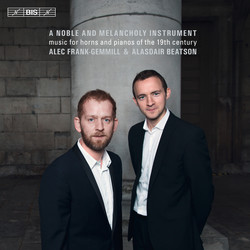 Alec Frank-Gemmill and Alasdair Beatson. A Noble and Melancholy Instrument: Music for Horns and Pianos of the 19th Century. BIS, 2017 (BIS-2228, Hybrid SACD). www.bis.se. Recorded January 2016 in Cologne, Germany.
Alec Frank-Gemmill and Alasdair Beatson. A Noble and Melancholy Instrument: Music for Horns and Pianos of the 19th Century. BIS, 2017 (BIS-2228, Hybrid SACD). www.bis.se. Recorded January 2016 in Cologne, Germany.
This recording is well worth the investment and time required for attentive listening. Overall, Alec Frank-Gemmill displays beautiful horn playing, agile technical ability, excellent tone quality
, and characteristically appropriate performances. Throughout the recording, Frank-Gemmill and pianist Alasdair Beatson make use of various horns and pianos for the different pieces. The choices of horns and pianos are historically accurate and it is valuable to hear the pieces played on instruments such as these:
Horns:
- Cor d’orchestre by Lucien Joseph Raoux, c. 1800. Paris
- Wienerhorn (with rotary valves) by Erste Wiener Productiv-Genossenschaft der Musik-Instrumentenmacher, late 19th Vienna
- Cor solo by Marcel August Raoux, 1823. Paris
- Cor a pistons by Victor Charles Mahillon, early 20th Brussels
Pianos:
- Salvatore Lagrassa, c. 1815. Palermo (Viennese school): 6 octaves, entirely wooden frame
- Jean Baptiste Streicher, 1847. Vienna: 7 octaves, 2 iron braces
- Julius Blüthner, 1867. Leipzig: 7 octaves, 4 iron braces, hitch-pin plate
- Carl Bechstein, 1898. Berlin: 7 ¼ octaves, cast iron frame
This recording presents a collection of pieces that is very standard repertoire and we are not given any real surprises in programming. However, some delightful surprises await the listener throughout the CD. For example, in Beethoven’s Sonata in F Major, skillful choices of alternate notes in some melodic passages lend the performance an urgency that captures the listener’s attention. In Schumann’s Adagio and Allegro, we hear a technically impressive and lyrically rewarding performance. The only real disappointment for my ear in this recording was in the performance of Franz Strauss’s Nocturne. The playing was beautiful, but the tempo was entirely too fast for this listener. The performance felt rushed, taking a bit away from the lyrical depth of the piece. If the Strauss Nocturne feels rushed, rest assured that in Rossini’s Prelude, Theme, and Variations and the Romance in E Major by Saint-Saëns we are presented a dazzling display of natural horn technique.
For Alexander Glazunov’s Rêverie, we are treated to a very interesting rendition using the combination of valves and hand horn technique. Given Glazunov’s penchant for older styles of music, this makes sense. However, it was surprising to hear the piece performed this way, given that so much late 19th century Russian horn music was written for horn in F, without any indication for use of natural horn technique. From studying the works of Tchaikovsky and conducting some research on the use of the horn in Russia during the late 19th century, it is my understanding that German speaking musicians who worked in Russia influenced the use of the valved horn as a fully chromatic instrument. When we consider this context, hearing Glazunov’s piece performed this way is striking. Glazunov was, however, a conservative musician who looked to the past and there was a time when the nobles in Moscow were influenced by French sensibilities. Drawing such connections may be tenuous, but they are interesting nonetheless.
As with the Glazunov, the final two pieces on the CD make use of the Mahillon piston horn. In Dukas’s Villanelle, Frank-Gemmill plays the opening as though on natural horn, using hand stopping technique, following the indication of the composer. He then uses the valves throughout the remainder of the piece, except for the passage expressly marked to be played stopped. No indication is provided regarding the mute used in the recording, so it is not apparent whether a historic mute was used or not. And in the final piece on the recording, Hunter’s Moon by Gilbert Vinter, it is fascinating to imagine we are hearing the likes of Dennis Brain, given that he recorded on a similar instrument.
-- Eric Brummitt



